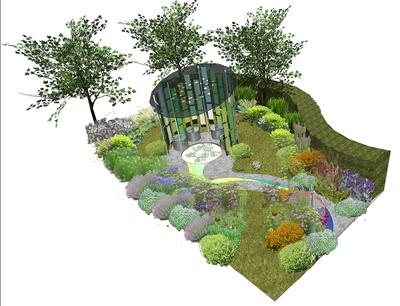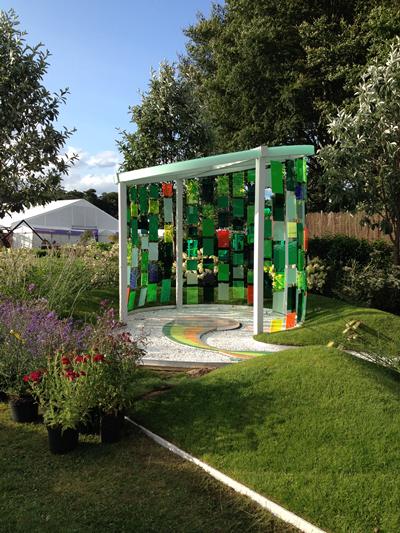IYL 2015 Garden makes Light work of understanding science

The University of Southampton has joined with Elks-Smith Landscape & Garden Design to create a spectacular ‘Garden of Light’ for the RHS Tatton Flower Show in Cheshire (22-26 July) in celebration of the United Nations International Year of Light.
News update - The garden has won the People's Choice Award for Best Large Garden. The garden also won a gold award in the Year of Light Garden category in recognition of the high-standard of the garden brief, design and build.
The Optoelectronics Research Centre (ORC) and Physics and Astronomy at the University have collaborated with BALI Design Excellence award-winning garden designer Helen Elks-Smith to design a garden that takes visitors on a journey into the world of light-based technology, known as photonics and its foremost communications channel, fibre optics.
Drawing parallels with nature, the garden shows how fibre optics, which transmit light over huge distances, are bundled together to form fibre optic cables capable of transferring vast qualities of data. These cables, which circle the globe in the ground and under the sea, form the backbone of the Internet and provide the high-speed telecommunications we take for granted today. Fibre optics are also used in cutting edge manufacturing research and when used with lasers focus light powerfully and with great precision.

The garden’s pavilion roof reflects a ‘holey fibre’ structure, a new type of optical fibre which allows light to travel faster over longer distances. Set into the pavilion floor are fibre optic glass ‘drops’, created as part of the fibre fabrication process. These and the wave-form in the path through the garden are a metaphor for how light reflects along the fibres.
The perspex rods within the landform represent the fibre ‘preforms’ which may be considered in this context as the ‘seeds’ of the optical fibre. During fibre fabrication, the preforms are ‘grown’ as they are heated and drawn out into the lengths of optical fibre - often thinner than a human hair. The finished fibres transmit data in the form of digital light pulses.
The garden highlights the advances in optical fibre research pioneered by the ORC. The incredible growth in Internet usage has been made possible by the ORC’s revolutionary developments in fibre optics technology. Scientists at the ORC invented the key optical fibre technology which forms the Internet as well as the erbium doped fibre amplifier (EDFA). It is this device in particular, the world’s first practical optical amplifier, which enables light to travel further and faster in fibre optic cables.
Deanna Standen, from the ORC, said: “Significantly the optical fibres that form the infrastructure of the Internet and the fibre amplifiers that power it, may be likened to the incredible symbiotic relationship of roots and fungi that our world would be barren without. Many of the fibres fabricated at the ORC have uncommonly similar structure to many plant stems, seeds and other organic matter that nourish our planet.”
Garden designer Helen Elks-Smith said: “I am delighted to be working with the University of Southampton’s ORC and for the support of the EPSRC Centre for Innovative Manufacturing in Photonics to help raise public awareness of its ground breaking photonics research at RHS Tatton; it’s such a good opportunity for public engagement.”
Scientists from the University’s public engagement and outreach programmes will be demonstrating in the garden on Wednesday 22 and Thursday 23 July during the show. Visit the garden and learn first-hand about this fascinating technology in a beautiful setting.